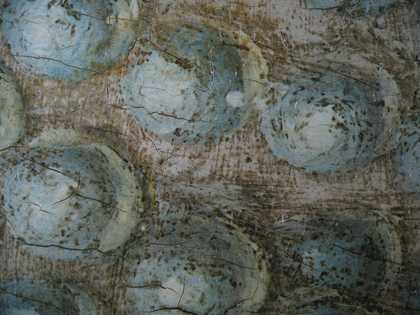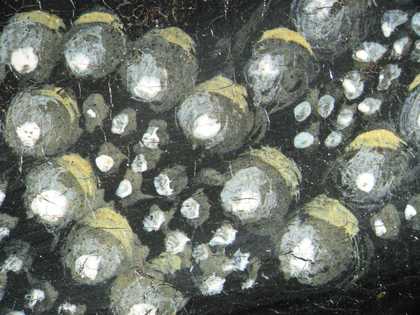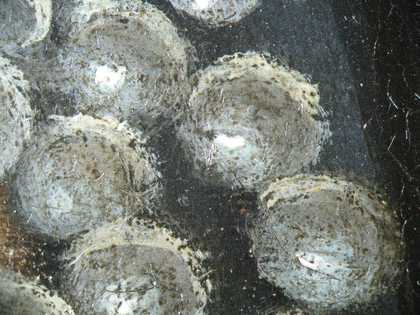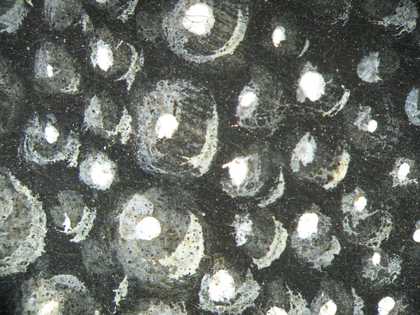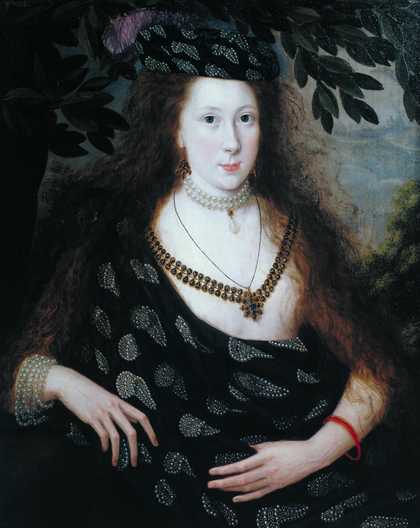
Fig.1
Robert Peake ?1551−1619
Lady Elizabeth Pope
c.1615
Oil on panel
770 x 608 mm
T00067
This painting is in oil paint on an oak panel measuring 770 x 608 mm (fig.1). The panel is composed of three oak boards of unequal width, placed side by side and glued together at butt joins, which appear never to have needed repair (fig.2). The thickness of the individual planks varies; there are steps on the reverse at both joins (fig.3). Examination of the wood with dendrochronology revealed that the oak is of Eastern Baltic origin.1 The earliest probable felling date for the trees from which the boards were derived is 1599 with conjectural usage dates of 1599−1617.
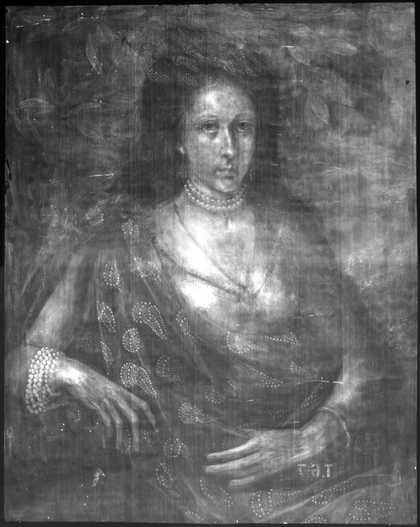
Fig.2
X-radiograph of Lady Elizabeth Pope c.1615
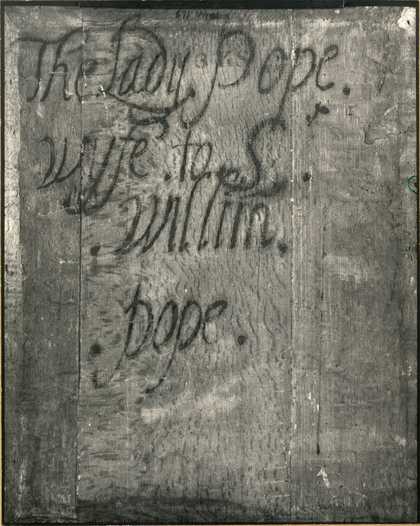
Fig.3
The reverse of Lady Elizabeth Pope c.1615, photographed in black and white
The panel is bevelled on all four reverse edges. From the measurements of the bevels’ width it is possible that the upright edges have been trimmed slightly − perhaps by 2−3 mm on each side. When the front of the panel is viewed in raking light, horizontal tooling marks are visible beneath the paint, and the reverse bears the marks of an adze. The panel has suffered localised damage from woodworm in the past; if the adze marks are original, then this infestation occurred prior to the panel’s construction, as the adze marks cut through worm channels.

Fig.4
Cross-section through foliage at the bottom edge, photographed at x320 magnification. From the bottom up: white ground; black particles, perhaps a dark wash of paint; brownish grey priming; green paint
The ground is a single, off-white layer of marine chalk bound in glue, smoothly applied; its thin application allows the texture of the wood grain to be apparent beneath the paint. The ground is covered over by opaque, brownish grey priming, composed of lead white and black bound together in oil. Its brushy texture is visible beneath the paint in the sky and in cross-section (fig.4). A cross-section through the green foreground foliage at the bottom edge (fig.4), shows a line of black particles between the ground and the priming, perhaps indicating very rough drawing applied directly onto the ground; it would remain dimly discernible through the brushily applied priming. Although the priming was not left visible as a colour in the finished painting, its presence as a half-tone shadow can be seen here and there, for example in the sitter’s right hand (fig.5).
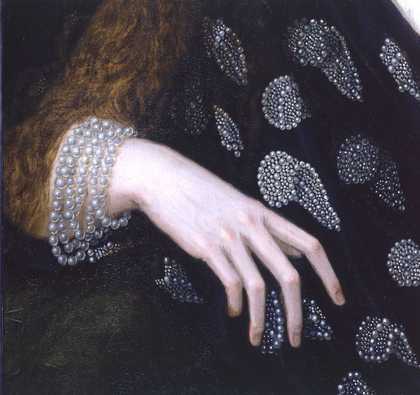
Fig.5
Detail of the sitter’s right hand, showing the brownish grey priming at the end of the little finger
With close inspection and with infrared reflectography, fine, free-hand drawing lines are visible in and round the eyes, at the proper left eyebrow and in the nose and the mouth (figs.6–7).
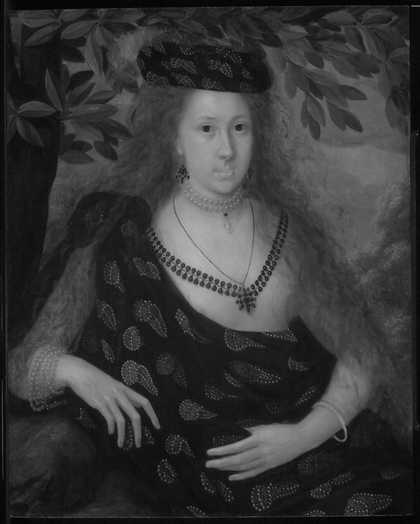
Fig.6
Infrared reflectograph of the whole painting
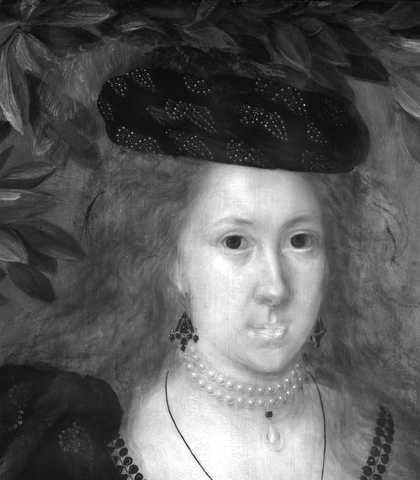
Fig.7
Detail in infrared of the face
In all these areas the proper left of the features has been adjusted from a slightly higher position further to the left. Stronger drawing lines clearly define the hands, fingers and the arms (figs.8–9). There are also strong, seemingly random lines within these areas that may indicate that folds of fabric were intended to cover parts of the flesh. There is no evidence of the underdrawing in red lake paint that appears to be present in the companion portrait by Peake of Lady Anne Pope (Tate T00068).
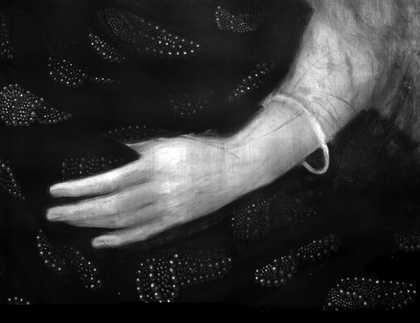
Fig.8
Infrared detail of the sitter’s left hand

Fig.9
Infrared detail of the sitter’s right hand
The painting is of very fine quality and displays evidence of careful planning. Reserves were created for the main elements of the composition, for example the mass of foliage next to the sky on the right, and there are very few alterations. Small elements, such as the pearl decorations, were applied on top of the black costume paint but more prominent items, such as the elaborate necklace, were given a reserve space within the flesh tone, as evident in the X-radiograph (fig.2). There are also some distinctive characteristics in the mixing of the colours. The whites of the eyes have what looks like blue azurite mixed plentifully with lead white to create the cool tone; the same blue pigment occurs with lead white, red lake, vermilion and black for the flesh tones (figs.10–11).2
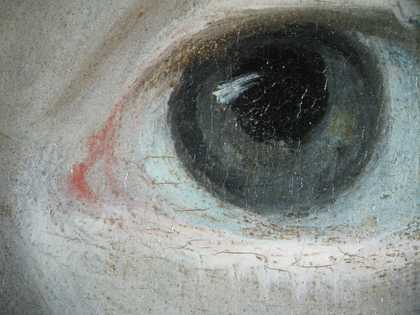
Fig.10
Detail of the sitter’s left eye, photographed at x8 magnification. Blue pigment in the eyeball

Fig.11
Detail of the blue pigment in the right eyeball, photographed at x100 magnification
It occurs also in some of the pearls (figs.12–15). Orpiment, realgar, yellow lake and chalk were used in mixtures for the gold mounts of the elaborate necklace (fig.16).
The sky is painted with smalt mixed with chalk, red lake and lead white, while the foliage was created from mixtures of azurite, smalt, lead tin yellow, black, lead white, chalk, vermilion, yellow lake, earth colours and Cologne earth. The black of the costume is made from bone black mixed with chalk, lead white, smalt and vermilion. The vermilion paint of the coral bracelet shows signs of deterioration and blackening of the surface under strong magnification, and there is a general presence of lead soap aggregates, which appear to originate in the priming, but otherwise the painting is in very good condition.
The painting was cleaned and restored in 1970. Its varnish is a modern synthetic resin.
2005

